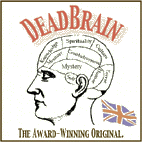
Vol. 2, Issue 10, March 9, 2004







Good-smelling Condors Years Away, Warn Scientists

In a significant setback for the condor preservation program, scientists at the University of California, San Diego and the San Diego Zoo announced today that its experimental breeding program will not meet its goal of improving the condor population by 2005.
"I would like to say that this is extremely disappointing for all of us," said Clarence Barnes, biology professor at UC San Diego and lead scientist on the project. "Unfortunately our sample size is very limited, and the kinds of modifications we are attempting take significant amounts of trial and error."
California condors are found in the arid foothills and mountain ranges of southern and central California. They roost in rocky cliffs or in trees, from the late afternoon until the next mid-morning. The birds are strikingly large, with wingspans of over 9 feet, and have long been a poster child of the endangered species recovery movement. However, despite their grandeur they face significant obstacles as scientists labor to nurse the species back to a sustainable level.
"Well, they're vultures, basically," said Barnes. "I mean, we call them condors and avoid discussing the fact that they're carrion eaters; but it is really hard to build public support for an animal that smells like a pile of rotting carcasses."
Apparently the San Diego Zoo has been attempting to use genetic manipulation to produce more media-friendly birds with broader appeal to the general public. While details on the program are still sketchy, it appears that the program has been trying to produce condors which exude a fresh scent of roses and are covered in soft golden feathers.
"From head to toe," emphasized Barnes. "Like all vultures, the condor's head is hairless and frankly it's not a pretty sight." Despite the program's best efforts, the modified hatchlings are not only still bald, but they also possess a new set of musk glands analogous to those found in a skunk.
Environmentalists decried the announcement as evidence that the government is not acting responsibly in its administration of the Endangered Species Act.
"This is absolutely outrageous," fumed Sierra Club president Larry Fahn. "These scientists are operating completely outside the bounds of moral or ethical principles. Plus they have the marketing sense of a donkey. If they're going to muck up the genome of such an endangered species the least they can do is aim for a result that will have brandability. A condor with enough breast meat to use in a new kind of McNugget or something - now that would have a practical application."
The San Diego program has apparently produced approximately fifteen viable modified condors to date. Barnes refused to speculate on a timeframe for the successful creation of a sweet-smelling condor.
"Don't hold your breath," said Fahn. "Actually, until they succeed, maybe you'd better."






